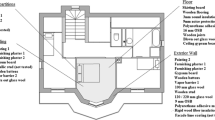Abstract
A new mass transfer model is developped to predict the volatile organic compounds (VOCs) from fresh wet building materials. The dry section of wet materials during the process of VOC emission from wet building materials is considered in this new model, differing from the mass transfer-based models in other literatures. The mechanism of effect of saturated vapor pressure on the surface of wet building materials in the process of VOC emission is discussed. The concentration of total volatile organic compounds (TVOC) in the building materials gradually decreases as the emission of VOCs begins, and the vapor pressure of VOCs on the surface of wet building materials decreases in the case of newly wet building materials. To ensure the partial pressure of VOCs on the surface of wet building materials to be saturated vapor pressure, the interface of gas-wet layer is lowered, and a dry layer of no-volatile gases in the material is formed. Compared with the results obtained by VB model, CFD model and the experiment data, the results obtained by the present model agree well with the results obtained by CFD model and the experiment data. The present model is more accurate in predicting emission of VOC from wet building materials than VB model.
Similar content being viewed by others
References
Su H J, Chao C J, Chang H Y, et al. The effects of evaporating essential oils on indoor air quality. Atmosph Env, 2007, 41(6):1230–1236
Brown S K. Chamber assessment of formaldehyde and VOC emission from wood-based panels. Indoor Air, 1999, 9: 209–215
Haghighat F. Material emission rates: Literature review, and the impact of indoor air temperature and relative humidity. Build Env, 1998, 33(5): 261–277
Meininghaus R, Salthammer T, Knoppel H. Interaction of volatile organic compounds with indoor materials—A small screening method. Atmosph Env, 1999, 33(15): 2395–2401
Xu Y, Zhang Y P. A general model for analyzing VOC emission characteristics from building materials and its application. Atmosph Env, 2004, 38(1): 113–119
Hu H P, Zhang Y P, Wang X K, et al. An analytical mass transfer model for predicting VOC emission from multi-layered building materials with convective surfaces on both sides. Inter J Heat Mass Transf, 2007, 50(11-12): 2069–2077
Zhu J P, Zhang J S, Shaw C Y. Comparison of models for describing measured VOC emissions from wood-based panels under dynamic chamber test condition. Chemosphere, 2001, 44(5): 1253–1257
Guo Z S, Chang J C S, Sparks L E, et al. Estimation of the rate of VOC emissions from solvent-based indoor coating materials based on product formulation. Atmosph Env, 1999, 33(8): 1205–1215
Guo Z S, Sparks L E, Tichenor B A, et al. Predicting the emissions of individual VOCs from petroleum-based indoor coatings. Atmosph Env, 1998, 32(2): 231–237
Yang X, Chen Q, Zeng J, et al. A mass transfer model for simulating volatile organic compound emissions from ‘wet’ coating materials applied to absorptive substrates. Inter J Heat Mass Transf, 2001, 44(9):1803–1815
Xu Y, Zhang Y P. An improved mass transfer based model for analyzing VOC emissions from building materials. Atmosph Env, 2003, 37(18): 2497–2505
Søren K. Drying of latex films and coatings: Reconsidering the fundamental mechanisms. Progress Org Coat, 2006, 57(3): 236–250
Author information
Authors and Affiliations
Corresponding author
Additional information
Supported by the National Natural Science Foundation of China (Grant No. 50776006) and the 863 Program (Grant No. 2006AA05Z228)
About this article
Cite this article
Zhang, T., Jia, L. A mass transfer model for predicting emission of the volatile organic compounds in wet building materials. Chin. Sci. Bull. 53, 2701–2705 (2008). https://doi.org/10.1007/s11434-008-0322-5
Received:
Accepted:
Published:
Issue Date:
DOI: https://doi.org/10.1007/s11434-008-0322-5




